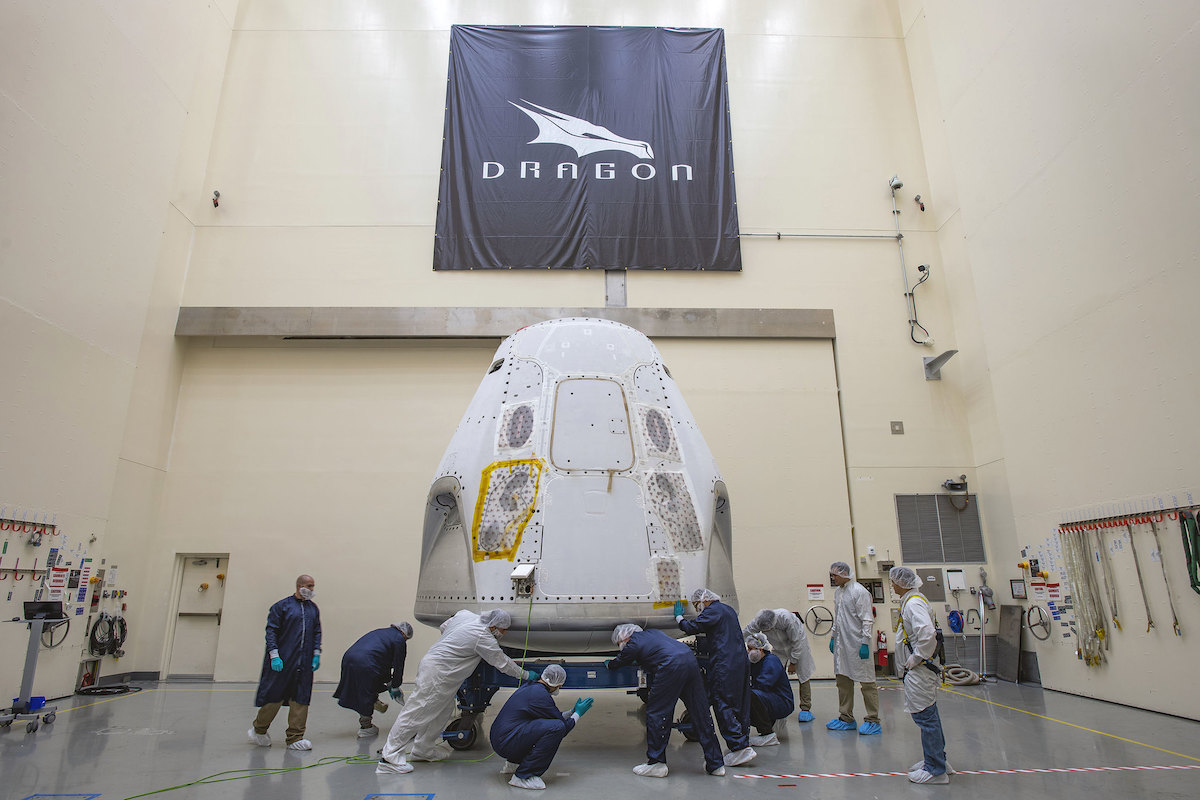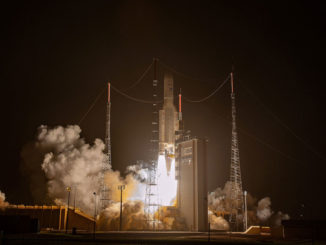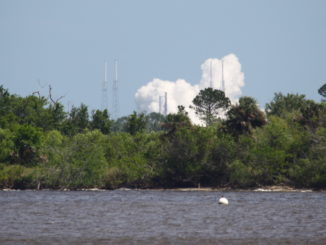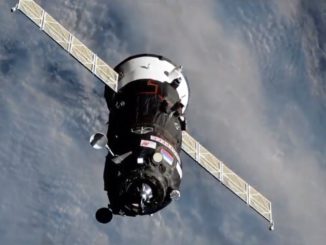EDITOR’S NOTE: Updated Feb. 15 after NASA modified original statement to remove words saying SpaceX will be the first commercial crew provider to fly astronauts.

SpaceX’s next Crew Dragon capsule was delivered to Cape Canaveral this week from a California factory for a liftoff as soon as this spring with veteran NASA astronauts Doug Hurley and Bob Behnken on a test flight to the International Space Station, officials announced Friday.
The human-rated spaceship arrived at a test and processing facility at Cape Canaveral Air Force Station Thursday following a cross-country trip from SpaceX headquarters in Hawthorne, California.
SpaceX tweeted a photo of the crew capsule Friday, showing ground teams wearing lab coats and hair nets rolling the capsule into position on a wheeled trolley soon after arriving on Florida’s Space Coast.
“The SpaceX Crew Dragon spacecraft for its first crew launch from American soil has arrived at the launch site,” NASA said in a statement. “NASA and SpaceX are preparing for the company’s first flight test with astronauts to the International Space Station as part of the agency’s Commercial Crew Program.”
In a previous version of the statement Friday, NASA said the Crew Dragon will be the first spacecraft to launch astronauts from U.S. soil since 2011, when the space shuttle was retired.
But the space agency updated the statement without explanation, and deleted a tweet from the commercial crew program’s Twitter account that said SpaceX’s Crew Dragon spacecraft will be the first to fly astronauts into orbit from U.S. soil since 2011.
In 2014, NASA tapped Boeing and SpaceX with contracts valued at $4.2 billion and $2.6 billion, respectively, to develop, test and fly commercial human-rated spacecraft designed to ferry astronauts to and from the space station.
Barring a major setback, SpaceX is widely expected to be ready to fly astronauts before Boeing.
The Crew Dragon spacecraft will lift off on top of a SpaceX Falcon 9 rocket from pad 39A at NASA’s Kennedy Space Center, the same departure point as the Apollo 11 moon landing mission, and the first and last space shuttle flights.
Hurley, a pilot on two space shuttle missions, will serve as vehicle commander on the Crew Dragon test flight, known as Demo-2. Behnken, also a veteran of two shuttle flights, will be the vehicle pilot.
NASA officials are considering launch dates in May for the Demo-2 mission, but the schedule could shift as SpaceX steps through launch preparations. The space station’s busy schedule of visiting crew and cargo vehicles could also change, forcing a shift in the Demo-2 launch date.
Another factor that could drive the Demo-2 launch schedule is additional training for Hurley and Behnken in case NASA extends their stay on the space station.
The first piloted missions aboard the Crew Dragon and Boeing Starliner spacecraft were originally designed as shorter-duration test flights lasting days or weeks. After the test flights, NASA intended to certify the two spacecraft for longer-duration missions lasting up to 210 days for regular crew rotation flights to the space station.
But delays in the readiness of the new commercial crew spaceships forced NASA to consider extending the duration of the test flights. NASA has purchased seats on Russian Soyuz capsules flying to the station, which have provided the only ride to the orbiting research complex for U.S. astronauts since 2011.
The last Soyuz mission with a seat currently under NASA’s control launches April 9 and returns to Earth in October. With reduced demand from NASA expected after the start of SpaceX and Boeing crew services, Russia slowed the manufacturing of new Soyuz vehicles.
But the Crew Dragon and Starliner spacecraft were not ready when NASA expected. The space station typically has a crew of six, but with the slower rate of Soyuz launches, the research lab will operate with a crew of three for most of 2020, at least until a U.S. vehicle arrives with reinforcements.
The space agency has approved an extension of the first crewed Starliner mission to last up to six months. NASA may also approve a months-long extension of the Crew Dragon’s Demo-2 mission to ensure the space station is staffed with more than three crew members.
That gives station managers more flexibility in planning repairs and scientific research.
Hurley and Behnken are training to live and work aboard the station in case NASA authorizes the astronauts to stay in orbit longer than initially planned. Hurley is training as a robotic arm operator, and Behnken is receiving refreshed training on spacewalks.
A SpaceX Crew Dragon spacecraft completed a successful six-day automated test flight to the space station in March 2019, but the capsule exploded in a ground test last April just before ignition of the ship’s SuperDraco launch abort engines on a test stand at Cape Canaveral.
The spaceship was destroyed in the accident, and SpaceX determined nitrogen tetroxide propellant leaked into the abort propulsion system’s high-pressure helium lines before the test-firing. The activation of the abort system during the ground test forced the nitrogen tetroxide back into a titanium valve at high energy, leading to ignition and an explosion.
SpaceX changed the design of the pressurization system by replacing the reusable valve with a single-use “burst disk,” which is designed to separate different sides of the fluid lines, then rupture before ignition.
The redesigned abort propulsion system aced a high-altitude launch abort test Jan. 19, when SpaceX demonstrated the Crew Dragon’s ability to escape an in-flight rocket failure. The capsule — with two instrumented test dummies on-board — separated from the top of its Falcon 9 launcher in the upper atmosphere and parachuted to a splashdown in the Atlantic Ocean.
The in-flight abort demonstration last month was the last major Crew Dragon test flight before NASA approves SpaceX to launch astronauts. Lower-level testing continues, including several upcoming drop tests of a Crew Dragon mock-up to gather additional data on parachute performance.
Boeing’s Starliner crew capsule flew its first unpiloted test flight in orbit in December, but the mission encountered multiple in-flight malfunctions, primarily caused by software problems. The Starliner capsule returned to Earth for a successful landing, but could not dock with the space station as intended.
Engineers have identified at least two software errors that occurred during the abbreviated mission.
One of the errors was disclosed soon after the Starliner’s launch Dec. 20 aboard a United Launch Alliance Atlas 5 rocket. The spacecraft’s mission elapsed timer had a wrong setting, causing the capsule to miss a planned orbit insertion burn before ground controllers could intervene to manually command the maneuver.
The error caused the spacecraft to burn too much fuel to reach the space station, and Boeing and NASA officials decided to bring the Starliner back to Earth two days later at White Sands Space Harbor in New Mexico.
But engineers found a second software defect as they reviewed the spacecraft’s code following the mission timing malfunction on launch.
Boeing teams discovered an error in the software controlling the Starliner service module’s separation sequence before re-entry. The mis-configured software could have led the service module to drive back into the Starliner’s crew module on the unpiloted test flight, possibly damaging the capsule, or worse.
The second software error was not disclosed by Boeing or NASA until last week.
Boeing is reviewing all of the crew capsule’s software code to look for other potential defects after investigators discovered “numerous process escapes in the software design, development and test cycle for Starliner,” said Doug Loverro, head of NASA’s human spaceflight division, in a media teleconference last week.
NASA and Boeing officials have not determined whether another the Starliner spacecraft needs to fly another test flight without astronauts before proceeding with a crew mission.
Email the author.
Follow Stephen Clark on Twitter: @StephenClark1.



